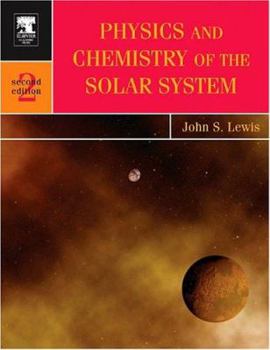Physics and Chemistry of the Solar System (Volume 87) (International Geophysics, Volume 87)
Select Format
Select Condition 
Book Overview
Physics and Chemistry of the Solar System, 2nd Edition, is a comprehensive survey of the planetary physics and physical chemistry of our own solar system. It covers current research in these areas and... This description may be from another edition of this product.
Format:Paperback
Language:English
ISBN:012446744X
ISBN13:9780124467446
Release Date:February 2004
Publisher:Academic Press
Length:655 Pages
Weight:3.50 lbs.
Dimensions:10.8" x 1.3" x 8.5"
Customer Reviews
2 ratings
A Little Bit Of Everything
Published by Thriftbooks.com User , 19 years ago
I teach a class in Planetary Atmospheres at the local state university (Arkansas). There is no dedicated text on planetary atmospheres for the non-expert, but you can take parts of this book and do pretty well. And that's the general theme of this book: it has at least a little bit of coverage on almost every aspect of the solar system. I think you could easily do the same thing for a class in planetary geology or solar system evolution or orbital dynamics or even a little biology. Nothing is explored in tremendous detail, but almost every sub-topic of the solar system receives good coverage. Geology is probablly the most-addressed topic. The book is a great read to just learn about the solar system and how it got here, but you'll need a strong background in chemistry and physics to really understand it. It was one of my favorite books even before I was selected to teach this course. Lewis' writing is folksy at time, and that's a good thing. Sometimes he's even funny. He gives some thorough overviews of the history of figuring out the various aspects of our solar system, such as the long history of figuring out the composition of the atmospheres of Venus and Mars. It's definitely not a dry book. The one downside is probably not the author's fault: the photographs are very poorly reproduced. This is probably a publisher thing, but pictures that I know to be beautiful are reduced to grainy, low-res grayscale. Also, be careful which one you order: there is a first edition, a revised first edition and a second edition. You want the latter, although they are not vastly different from one another. The second edition has some color plates grouped together, and this helps. I recommend this book enthusiastically for anyone with a technical background that wants to learn more about any aspect of the solar system.
A great book loaded with practical information.
Published by Thriftbooks.com User , 26 years ago
Chapters: I. Introduction; II. Astronomical Perspective; III. General Description of the Solar System; IV. The Sun and the Solar Nebula; V. The Major Planets; VI. Pluto and the Icy Satellites of the Outer Planets; VII. Comets and Meteors; VIII. Meteorites and Asteroids; IX. The Airless Rocky Bodies: Io, Phobos, Deimos, the Moon, and Mercury; X. The Terrestrial Planets: Mars, Venus, and Earth; XI. Planets and Life about Other Stars; XII. Future Prospects; Appendices; Suggested Reading; IndexThis book discusses the physics and chemistry of the Solar System in great detail. It assumes that the reader has completed one year of mathematics, physics, and chemistry at the university level. Appropriate physics and chemistry formulas and equations are sprinkled throughout the book. The focus is on practicality, not on rigorous derivation: Formulas are often introduced with a phrase like "It can be shown that...", though some key concepts are discussed in more math! ematical detail in the appendices. For the reader who wants more, the "Suggested Reading" section lists many more publications dealing with aspects of the subject matter of this book, ranging in intended readership between non-mathematical and professional scientific.The text is informative and to the point. Inclusion of many results from recent space missions to various planets, asteroids, and comets is evident. The author includes many pictures (mostly in black and white) of (parts of) the planets and other discussed celestial bodies. Also included are a great number of plots and diagrams that illustrate points made in the text. Many provide specific information on characteristics of the materials being discussed. I particularly like these diagrams: A general discussion of, for instance, the different kinds of water ice is interesting in its own right, but the inclusion of a diagram where you can look up your own favorite combination of temperature and press! ure to find which kind of water ice exists under those cond! itions allows you to consider also many situations that are not explicitly treated in the text.The book starts with a discussion that puts the Solar System in a wider astronomical context (involving galaxies and the universe at large), and ends (after extensive discussion of the members of the Solar System) with a discussion of the physics and chemistry of life and planets around other stars, and of the future prospects for answering remaining questions about our celestial neighbors. Some exercises are included at the end of each chapter.The only negative point I found about this book is that it does not discuss the one topic I was looking for when I bought it: the physics of the shape of celestial bodies. For instance, why can Mars support much taller mountains that the Earth? How irregular can the shape be of a moon or asteroid, depending on its size? This certainly falls within the scope of the title. Nevertheless, the great wealth and practicality of the other i!






